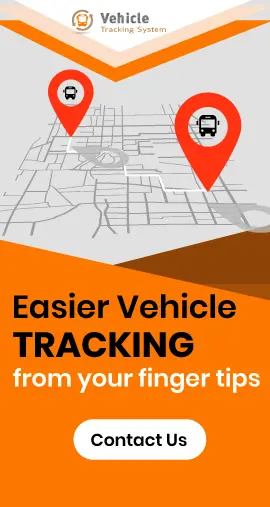Dominant Trends in Vehicle Tracking Technology
October 11th, 2017
The growth of the vehicle tracking system business is quite noticeable and inspiring worldwide when you analyze carefully. Vehicle tracking technology has contributed significantly to this.
As a result, most new vehicles in North America and Europe are equipped with this system. Moreover, Asian markets are experiencing remarkable growth.
In 2021, the market for vehicle tracking technology was valued at $17.37 billion, and it is projected to hit $109.95 billion by 2030, representing an 18.9% CAGR over the next five years.
Vehicle tracking technology is adopted by businesses due to the following factors
- Improving routing, maximizing stock utilization, and monitoring business operations can reduce logistics costs
- Security enhanced by the theft detection facility and real-time tracking of shipments.
- Size of tracking units and antennas is smaller to other devices, allowing for covert installation and mounting in a smaller area.
- Reconstruction of accidents using direction, docked position, speed, and acceleration data can assist insurance claims.
- Based on information from the previous locations, it provides superior and immediate service.
- Recover goods, vehicles, and assets as soon as possible.
- Puts a stop to fuel theft.
- The government must approve vehicle tracking devices before they can be installed.
- Streamline satellite positioning receivers and cellular modems, reduce their costs and size, and boost their performance.
- Monitoring driving behaviours (idling times, speeding, etc.) is a key to effective driver management.
- A solar-powered device that allows for extended battery life and continuous operation, exclusive to vehicle tracking devices that do not require an external source of power.
When dealing with the above scenarios, several hardware issues need to be addressed, and overcoming these problems is the number one priority in the future:
The ability to work with multiple global positioning satellites
It seemed like a long time ago when GPS was the only satellite system available.
Furthermore, the Russian GLONASS satellite navigation system is now fully operational, the Chinese BeiDou and Japanese Quasi-Zenith satellite navigation systems are partially running, and Galileo (the European Union’s global navigation system) will become fully operational by 2021
Compliance among these systems varies from one system to another, and the compatibility of these systems varies as well. The tracking application and GNSS will not operate simultaneously in the weak signal area. The issue is the location of the tracking application and when it is operating in that area.
Read Also: 10 Ways To Improve Your ROI with Vehicle Tracking System
The government’s authorization must also be taken into account; for example, in Russia, the GLONASS-compatible ERA-GLONASS call system should also be examined because of its GLONASS compatibility.
Satellite reception problems Managing
The GPS/GNSS satellites are capable of transferring 30 watts of power from a distance of 20 thousand kilometres, and they are locked to four satellites.
Therefore, measuring achievement and certainty will be more difficult in urban canyons, especially indoors or when the receivers are within metal containers.
The following techniques can be employed to resolve these issues:
1. An incorrect alignment
An ideal alignment of the satellite dish is necessary to receive the signal well. Goal is to make high-definition pictures as close to perfect as possible since a deviation of just five millimetres can make the difference between a perfect picture and no picture at all. Because of this, it is impossible to do an alignment with the naked eye since everything has to be calibrated to millimetres. Several reasons can explain the lack of precision in alignment. In general, weather conditions can completely shift the dish since strong winds and rain can completely move. It is also possible that a loosening of the bolts over time leads to unwanted movement of the satellite dish.
2. Uniform Deadline Estimating
Sensor data can enhance GNSS receivers to effectively report distance and heading changes from the last known position.
With such receivers installed in navigation systems for automobiles, navigation inside tunnels will be much more straightforward. Moreover, accelerometer data can be greatly enhanced when vertical displacement is considered carefully.
3. Issues with cables
Although we can’t always find the reason why we don’t get a good reception, the dish is one piece of equipment. You should check the cables next because even though they should last a long time, damaged cables will cause constant signal issues. The weatherproofing also consists of several layers to deal with the weather; however, as you are well aware, anything exposed to the sun for half a year and ice for the other half of the year will not last for decades. The cables should be physically inspected, and other diagnostics should be performed. It is only possible to change the cables if you find there is a problem with the cables. Obviously, you can do it on your own, but it’s faster and safer to have a pro handle the job.
4. Using a compound positioning procedure
This method involves the addition of a parallel system that speculates on the basis of Wi-Fi cells or visible mobile cells whenever GNSS satellite visibility is obstructed.
Having this information allows you to know how far away two points are, which is better than having no idea how far apart two points are, especially for shipments or moving vehicles.
Compatible with a variety of cellular standards
Satellite constellations that provide positioning, navigation, and timing (PNT) services on an international or regional basis are classified as global navigation satellite systems (GNSS).
PNT capability is supplemented by other GNSS, including those produced or, in some cases, already in use, by other nations. Those are the most important ones.
A GNSS can also refer to an augmentation system, as there are too many international augmentations to list here.

The GSM/GPRS standard lacks the capability to compete with next-generation 3G standards such as HSPA, CDMA2000, and LTE. Additionally, there are alternative 3G and 4G standards that operate with different frequencies.
Consequently, cellular modems which conform to a variety of standards while maintaining footprint compatibility on the same PCB need to come into being.
Because the tracking system is developed with regional variants or upgraded with next-generation tracking technology, the hardware costs are reduced.
Automotive Grade Components
In all vehicle tracking applications, it is vital that automotive-grade components are used. Automotive-grade components generally have extreme temperature ranges, voltage modulations, and safety designs that violate the rules.
Read Also: Understanding ROI- What it is and How it can Help Improve your Vehicle Tracking Productivity?
It depends on the design and producer of the PCBs that make up these electronic devices if they are to meet the requirements for the deployment of critical automotive systems. Design and development must comply with regulatory requirements based on the following factors: vehicle automation classification, SAE J3016_201401, board type (rigid, IPC-6012DA, flex or rigid-flex, IPC-6013D), quality management, IATF 16949, and the board performance class, IPC-6011.
The materials used to manufacture these components with “automotive-grade” should be certified according to AEC-Q100, fabricated at ISO/TS 16949 certified sites, and undergo full system testing in their respective factories.
The ISO16750 standard should be followed for all qualification tests. Each business that runs on vehicles, such as transportation companies, requires a vehicle tracking system.
Final Thoughts
Despite the lack of satellite visibility in some regions of the country, vehicle tracking technology today are designed to support regional satellite and cellular compatibility, support hardware variants, and upgrades. They are capable of meeting automotive quality requirements.
A vehicle tracking system is guaranteed to have a long lifespan. However, the most important thing is to design it with consideration for future technological developments while still accommodating the current technology.


